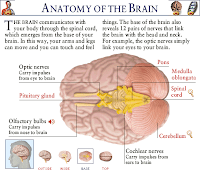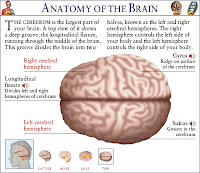Brain Cancer Treatment
Treatment for brain tumor should be individualized. It should be based on your age, general health, and the size, location, and type of your tumor.
You and your loved ones will have many questions about cancer, the
treatment, side effects, and the long-term outlook. Your health care
team is the best source of this information. Don't hesitate to ask.
For more information from the National Cancer Institute about childhood astrocytomas, see the following:
What You Need to Know About™ Brain Tumors
Pediatric Brain Tumor Consortium (PBTC)
Advances in Targeted Therapies
Targeted Therapies
For more childhood cancer information and other general cancer resources from the National Cancer Institute, see the following:
What You Need to Know About™ Cancer
Childhood Cancers
CureSearch for Children's Cancer
Late Effects o...
Brain Cancer Treatment Overview
Treatment of brain cancer is usually complex. Most treatment plans involve several consulting doctors.
- The team of doctors includes neurosurgeons (specialists in the brain and nervous system), oncologists, radiation oncologists (doctors who practice radiation therapy), and, of course, your primary health care provider. Your team may also include a dietitian, a social worker, a physical therapist, and, possibly, other specialists.
- The treatment protocols vary widely according to the location of the tumor, its size and type, your age, and any additional medical problems that you may have.
- The most widely used treatments are surgery, radiation therapy, and chemotherapy. In most cases, more than one of these is used.
Brain Cancer Surgery
Most people with a brain tumor undergo surgery.
- The purpose of surgery is to confirm that the abnormality seen during testing is indeed a tumor and to remove the tumor. If the tumor cannot be removed, the surgeon will take a sample of the tumor to identify its type.
- In some cases, mostly in benign tumors, symptoms can be completely cured by surgical removal of the tumor. The neurosurgeon will attempt to remove all the tumor when possible.
- Stereotactic radiosurgery is a newer "knifeless" technique that destroys a brain tumor without opening the skull. A CT or MRI scan is used to pinpoint the exact location of the tumor in the brain. High-energy radiation beams are trained on the tumor from different angles. The radiation destroys the tumor. There are various types of stereotactic radiosurgery.
- The advantages of stereotactic radiosurgery is that it has fewer complications and a shorter recovery time.
You may undergo several treatments and procedures before surgery.
- You may be given a steroid drug, such as dexamethasone (Decadron), to relieve swelling.
- You may be treated with an anticonvulsant drug to relieve or prevent seizures.
- If you have excess cerebrospinal fluid collecting around your brain, a thin, plastic tube called a shunt may be placed to drain the fluid. One end of the shunt is placed in the cavity where fluid collects; the other end is threaded under your skin to another part of the body. The fluid drains from the brain to a site from which the fluid can be easily eliminated.
Radiation Therapy for Brain Cancer
Radiation therapy (also called radiotherapy) is the use of
high-energy rays to kills tumor cells, thereby stopping them from
growing and multiplying.
- Radiation therapy may be used for people who cannot undergo surgery. In other cases, it is used after surgery to kill any tumor calls that may remain.
- Radiation therapy is a local therapy. This means that it affects only cells in its path. It does not harm cells elsewhere in the body or even elsewhere in the brain.
Radiation can be given in either of two ways.
- External radiation uses a high-energy beam of radiation targeted at the tumor. The beam travels through the skin, the skull, healthy brain tissue, and other tissues to get to the tumor. The treatments are usually given five days a week for certain amount of time. Each treatment takes only a few minutes.
- Internal or implant radiation uses a tiny radioactive capsule that is placed inside the tumor itself. The radiation emitted from the capsule destroys the tumor. The radioactivity of the capsule decreases a little bit each day; the amount of radioactivity of the capsule is carefully calculated to run out when the optimal dose has been given. You need to stay in the hospital for several days while receiving this treatment.








No comments:
Post a Comment